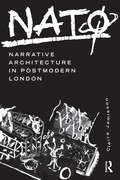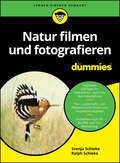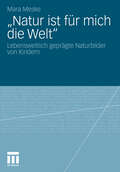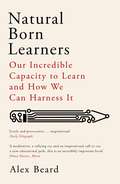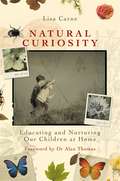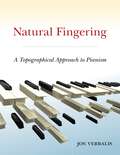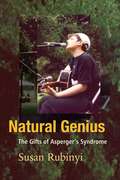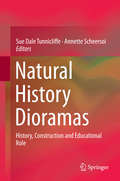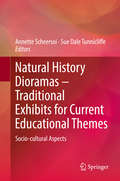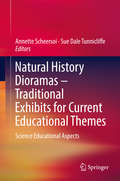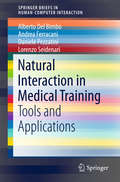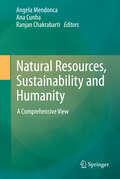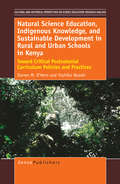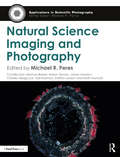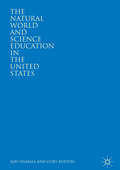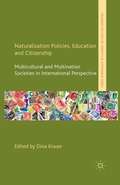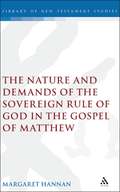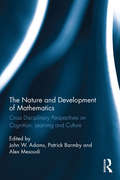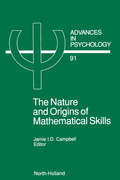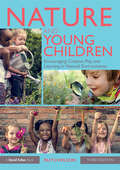- Table View
- List View
NATØ: Narrative Architecture in Postmodern London
by Claire JamiesonChronicling the last radical architectural group of the twentieth century – NATØ (Narrative Architecture Today) – who emerged from the Architectural Association at the start of the 1980s, this book explores the group’s work which echoed a wider artistic and literary culture that drew on the specific political, social and physical condition of 1980s London. It traces NATØ’s identification with a particular stream of post-punk, postmodern expression: a celebration of the abject, an aesthetic of entropy, and a do-it-yourself provisionality. NATØ has most often been documented in reference to Nigel Coates (the instigator of NATØ), which has led to a one-sided, one-dimensional record of NATØ’s place in architectural history. This book sets out a more detailed, contextual history of NATØ, told through photographs, drawings, and ephemera, restoring a truer polyvocal narrative of the group’s ethos and development.
NATØ: Narrative Architecture in Postmodern London
by Claire JamiesonChronicling the last radical architectural group of the twentieth century – NATØ (Narrative Architecture Today) – who emerged from the Architectural Association at the start of the 1980s, this book explores the group’s work which echoed a wider artistic and literary culture that drew on the specific political, social and physical condition of 1980s London. It traces NATØ’s identification with a particular stream of post-punk, postmodern expression: a celebration of the abject, an aesthetic of entropy, and a do-it-yourself provisionality. NATØ has most often been documented in reference to Nigel Coates (the instigator of NATØ), which has led to a one-sided, one-dimensional record of NATØ’s place in architectural history. This book sets out a more detailed, contextual history of NATØ, told through photographs, drawings, and ephemera, restoring a truer polyvocal narrative of the group’s ethos and development.
Natur filmen und fotografieren für Dummies (Für Dummies)
by Svenja Schieke Ralph SchiekeFangen Sie spannende Motive in der Natur ein – mit Ihrer Kamera Schon mit wenig Ausrüstung können Sie wunderbare Momente festhalten – nicht nur in Einzelbildern, sondern auch im Film. Wie Sie Landschaften und Tiere filmen und fotografieren, lernen Sie in diesem Buch. Svenja und Ralph Schieke zeigen Ihnen Schritt für Schritt von der Planung bis zur Veröffentlichung, wie spannende und interessante Naturfotografien und Naturfilme mit dem gewissen Etwas entstehen. Sie erfahren, wie Sie Motive finden, welche Ausrüstung Sie benötigen, was Sie bei den Aufnahmen beachten müssen und wie Sie Ihre Ergebnisse weiter bearbeiten. Sie erfahren Wie Sie auch mit Ihrem Smartphone gelungene Aufnahmen machen Warum sich die Stadt nicht verstecken muss, wenn es um Naturaufnahmen gehtWie Sie einen Film planen und in der Natur Schritt für Schritt umsetzenWo Sie Ihre Aufnahmen präsentieren können
"Natur ist für mich die Welt": Lebensweltlich geprägte Naturbilder von Kindern
by Mara MeskeNaturbilder sind ausschlaggebend für einen nachhaltigen Umgang mit sich selbst und gegenüber der Natur, denn - so die Hauptthese von Mara Meske - sie strukturieren und leiten das Verhalten. Da die Basis für diese Vorstellungen und Einstellungen durch in der Kindheit gemachte Erfahrungen in Familie, Schule und Lebensumfeld gelegt wird, stehen Kinder im Grundschulalter im Fokus der Analyse. Theoretisch und empirisch arbeitet die Autorin den Lebensweltbezug von Naturbildern heraus und erstellt eine Lebensweltanalyse aus Kindersicht. Mit der Rekonstruktion der Genese dieser Naturbilder und der Erstellung einer Typologie kindlicher Naturbildtypen liefert sie wichtige Ansatzpunkte für naturbezogene Bildungsprozesse.
Natural Born Learners: Our Incredible Capacity to Learn and How We Can Harness It
by Alex BeardLearning is the soul of our species. From our first steps to our last words, we are what we learn. But for all its obvious importance, learning has lost touch with human progress. We live in an information age, work in a knowledge economy, yet our schools are relics of an industrial era. Education insider Alex Beard takes us on a dazzling tour of the future of learning to show how we can - and why we must - do better. Tackling everything from artificial intelligence to our growing understanding of the infant brain, Natural Born Learners is a user's guide to transforming learning in the twenty-first century and roadmap to accessing our better future selves.
Natural Curiosity: Educating and Nurturing Our Children at Home
by Dr Alan Thomas Lisa CarneNatural Curiosity is a warm and contemplative insight into one family's experience of moving from mainstream schooling to home education, and learning through the lens of nature and natural history. Since becoming 'unschooled', the two children have thrived on a diet of self-directed play and learning, amassing life skills, confidence, responsibility, and a vast array of knowledge along the way. This thoughtful book touches upon important themes in education and environmentalism, such as children's rights in schooling, the use and place of technology in learning, and the absence of the natural world in mainstream education. It gives a considered, balanced view of home schooling, interspersed with entertaining tales including constructing life-sized mammoth skeletons and living for a day as historically accurate Vikings. It offers an understanding of how this type of education works and what inspires the choice to pursue it.
Natural Fingering: A Topographical Approach to Pianism
by Jon VerbalisThough incomplete at the time of his death in 1849, Chopin's Projet de méthode was nonetheless revolutionary in many respects. But with his Fundamental Pattern, Chopin announced the recognition, if not discovery, of the keyboard's extraordinary topographical symmetry and postulated a core formulation for a new "pianistic" pedagogy. More than a hundred years later the now-legendary Heinrich Neuhaus would passionately plead for this pedagogy and a pianism rooted in it. Natural Fingering explores this remarkable symmetry, significantly as it sheds light on fingering matters for the now vast catalogue of repertoire. It also examines the revolutionary impact of equal temperament on compositional key choice as well as the liberating influence of Charles Eschmann-Dumur's unique discoveries regarding symmetrical inversion. Author Jon Verbalis develops principles for a topographically-based fingering strategy that reflect a surprising compatibility of this fixed symmetrical organization with the most efficient biokinetic capabilities of the pianist's playing mechanism. He addresses previously neglected or overlooked technical aspects of pianism as they relate to movement in keyboard space generally as well as fingering specifically. Symmetrical fingerings for all the fundamental forms are presented in innovative, instructive format. The reader will also find an unusually extensive, in-depth discussion of double note challenges. Answering Neuhaus's call for the reappraisal of a certain pedagogical status quo, several chapters are devoted to the relevant implications of Chopin's Fundamental Pattern. The author also advances guidelines for a progressive implementation of natural fingering principles from the very start, as well as "retooling" for teachers and students alike. Of special note are the cross-hand major and minor scales for the earliest stages, in which the necessity of thumb under/hand over pivoting actions is eliminated. Natural Fingering is the first comprehensive discussion of fingering solutions for pianists since Hummel's monumental treatise of 1828. The book is complemented by a companion website, which serves as a supplement to the printed edition. The website features copious excerpts from the extant repertoire, extended discussions on relevant topics, and a comprehensive manual of the fundamental forms with symmetrically adjusted fingerings.
Natural Genius: The Gifts of Asperger's Syndrome (PDF)
by Susan RubinyiNatural Genius: The Gifts of Asperger's Syndrome is Susan Rubinyi's story of raising her son Ben who has Asperger's Syndrome (AS), and how she has come to view his condition as a blessing. While acknowledging the challenges posed by AS, she emphasizes the extraordinary positives of her son's life and his particular gifts - his photographic memory, perfect pitch and French-English bilingual abilities.
Natural History Dioramas: History, Construction and Educational Role
by Sue Dale Tunnicliffe Annette ScheersoiThis book brings together in a unique perspective aspects of natural history dioramas, their history, construction and rationale, interpretation and educational importance, from a number of different countries, from the west coast of the USA, across Europe to China. It describes the journey of dioramas from their inception through development to visions of their future. A complementary journey is that of visitors and their individual sense making and construction of their understanding from their own starting points, often interacting with others (e.g. teachers, peers, parents) as well as media (e.g. labels). Dioramas have been, hitherto, a rather neglected area of museum exhibits but a renaissance is beginning for them and their educational importance in contributing to people’s understanding of the natural world. This volume showcases how dioramas can reach a wide audience and increase access to biological knowledge.
Natural History Dioramas – Traditional Exhibits for Current Educational Themes: Science Educational Aspects
by Annette Scheersoi Sue Dale TunnicliffeThis book focuses on socio-cultural issues and the potential of using dioramas in museums to engage various audiences with – and in – contemporary debates and big issues, which society and the natural environment are facing, such as biodiversity loss.From the early 1900s, with the passage of time and changes in cultural norms in societies, this genre of exhibits evolved in response to the changes in entertainment, expectations and expressed needs of museum visitors. The challenge has always been to provide meaningful, relevant experiences to visitors, and this is still the aim today. Dioramas are also increasingly valued as learning tools. Contributions in this book specifically focus on their educational potential. In practice, dioramas are used by a wide range of educational practitioners to assist learners in developing and understanding specific concepts, such as climate change, evolution or or conservation issues. In this learning process, dioramas not only contribute to scientific understanding and cultural awareness, but also reconnect wide audiences to the natural world and thereby contribute to the well-being of societies.In the simultaneously published book: “Natural History Dioramas – Traditional Exhibits for Current Educational Themes, Science Educational Aspects" the editors discuss the history of dioramas and their building and science learning aspects, as well as current developments and their place in the visitor experience.
Natural History Dioramas – Traditional Exhibits for Current Educational Themes: Science Educational Aspects
by Annette Scheersoi Sue Dale TunnicliffeThis book presents the history of natural history dioramas in museums, their building and science learning aspects, as well as current developments and their place in the visitor experience. From the early 1900s, with the passage of time and changes in cultural norms in societies, this genre of exhibits evolved in response to the changes in entertainment, expectations and expressed needs of museum visitors. The challenge has always been to provide meaningful, relevant experiences to visitors, and this is still the aim today. Dioramas are also increasingly valued as learning tools. Contributions in this book specifically focus on their educational potential. In practice, dioramas are used by a wide range of educational practitioners to assist learners in developing and understanding specific concepts, such as climate change, evolution or or conservation issues. In this learning process, dioramas not only contribute to scientific understanding and cultural awareness, but also reconnect wide audiences to the natural world and thereby contribute to the well-being of societies.In the simultaneously published book: “Natural History Dioramas – Traditional Exhibits for Current Educational Themes, Socio-cultural Aspects” the editors focus on socio-cultural issues and the potential of using dioramas to engage various audiences with – and in – contemporary debates and big issues, which society and the natural environment are facing.
Natural Interaction in Medical Training: Tools and Applications (Human–Computer Interaction Series)
by Alberto Del Bimbo Andrea Ferracani Daniele Pezzatini Lorenzo SeidenariThis book covers state of the art techniques for health personnel training using natural interfaces, immersive systems and serious games paradigms. Opening with a comprehensive introduction to the state of immersive visualisation techniques of interaction and simulation used in the industry and training research, the authors then focus on computer vision techniques used to develop realtime training systems effectively, providing recognition of actions and re-identification of persons. Principles of serious gaming applied to immersive natural interfaces are also addressed.The book culminates with the presentation of two prototypes of immersive systems for natural interaction, that the authors have developed and tested for the training of medical personnel. These prototypes use the principles and the technologies described in the first part of the book. Natural Interaction in Medical Training offers a unique point of view from medical professionals and computer engineers.
Natural Resources, Sustainability and Humanity: A Comprehensive View
by Angela Mendonca, Ana Cunha and Ranjan ChakrabartiShortly, this book is the written up-graded version of the topics discussed during the Small Meeting of the 2nd International School Congress: Natural Resources, Sustainability and Humanity, held in Braga, Portugal, 5-8 May 2010 with the diverse participation of scientists, educators and governmental representatives. The Earth hosts an immense ecosystem, colonized by millions of species for billions of years but only for a few tens of thousands of years by humans. Environmental history tells though that it was humankind that shaped the environment as no other species. History, geography, religion and politics among other reasons have differentiated populations with respect to access to safe food and water, education, health, and to space and natural resource utilization. The globalization era of trade, information and communication is shortening distances and increasing overall wealth, but, as is pointed out in this book, it is also contributing to the propagation of diseases, and to the modification or even destruction of native ecosystems by exotic invasive species.Man is the only species that has the perception of its history, evolution, of the consequences of its decisions, and that there is a future ahead. It is also the only species that has the potential to change it. This awareness can be a source of anxiety and contradictory behaviours, but it is also the key to changing attitudes towards the construction of a common sustainable home, by committed education, interdisciplinary approaches, mobilization and empowerment of people and political consonant actions.
Natural Science Education, Indigenous Knowledge, and Sustainable Development in Rural and Urban Schools in Kenya: Toward Critical Postcolonial Curriculum Policies and Practices (Cultural Perspectives in Science Education #0)
by Darren M. O’Hern Yoshiko NozakiThrough a multi-sited qualitative study of three Kenyan secondary schools in rural Taita Hills and urban Nairobi, the volume explores the ways the dichotomy between “Western” and “indigenous” knowledge operates in Kenyan education. In particular, it examines views on natural sciences expressed by the students, teachers, the state’s curricula documents, and schools’ exam-oriented pedagogical approaches. O’Hern and Nozaki question state and local education policies and practices as they relate to natural science subjects such as agriculture, biology, and geography and their dismissal of indigenous knowledge about environment, nature, and sustainable development. They suggest the need to develop critical postcolonial curriculum policies and practices of science education to overcome knowledge-oriented binaries, emphasize sustainable development, and address the problems of inequality, the center and periphery divide, and social, cultural, and environmental injustices in Kenya and, by implication, elsewhere. “In an era of environmental crisis and devastation, education that supports sustainability and survival of our planet is needed. Within a broader sociopolitical context of post-colonialism and globalization, this volume points out possibilities and challenges to achieve such an education. The authors propose a critical, postcolonial approach that acknowledges the contextual and situational production of all knowledge, and that de-dichotomizes indigenous from ‘Western’ scientific knowledge.” Eric (Rico) Gutstein, Professor, Curriculum and Instruction, University of Illinois at Chicago (USA)
Natural Science Imaging and Photography (Applications in Scientific Photography)
by Michael R. PeresThis book provides an in-depth exploration of scientific photography. Highlighting the best practices needed to make, distribute, and preserve scientific visual information using digital photographic methods and technologies, it offers solutions to some of the biggest challenges facing photographers. Written by a team of international, award-winning image makers with over 300 years of cumulative experience, this comprehensive resource explains the foundations used, the tools required, and the steps to needed for creating the optimal photograph in a range of environments and circumstances. Topics covered include: • ethical practices • aerial photography • close-up and macro photography • computational photography • field photography • geological photography • imaging with invisible spectrums • photographing small animals in captivity • time-based imaging • image processing in science Showcasing modern methods, this book equips readers with the skills needed to capture and process the best image possible. Designed for basic and intermediate photographers, Natural Science Imaging and Photography exists as an essential contemporary handbook.
Natural Science Imaging and Photography (Applications in Scientific Photography)
by Michael R. PeresThis book provides an in-depth exploration of scientific photography. Highlighting the best practices needed to make, distribute, and preserve scientific visual information using digital photographic methods and technologies, it offers solutions to some of the biggest challenges facing photographers. Written by a team of international, award-winning image makers with over 300 years of cumulative experience, this comprehensive resource explains the foundations used, the tools required, and the steps to needed for creating the optimal photograph in a range of environments and circumstances. Topics covered include: • ethical practices • aerial photography • close-up and macro photography • computational photography • field photography • geological photography • imaging with invisible spectrums • photographing small animals in captivity • time-based imaging • image processing in science Showcasing modern methods, this book equips readers with the skills needed to capture and process the best image possible. Designed for basic and intermediate photographers, Natural Science Imaging and Photography exists as an essential contemporary handbook.
The Natural World and Science Education in the United States
by Ajay Sharma Cory BuxtonThis book focuses on the representation of nature in science education in schools in the United States. Given the importance of our relationship with the nonhuman world for the fate of our planet, this work gives special attention to the representation, instruction, and understanding of the relationship between the social and the natural world. It also proposes an alternative, sustainability science-based conceptual framework for ecology and environmental science topics in science education, which is compatible with the current social-ecological understanding of life in the Anthropocene epoch.
The Natural World and Science Education in the United States
by Ajay Sharma Cory BuxtonThis book focuses on the representation of nature in science education in schools in the United States. Given the importance of our relationship with the nonhuman world for the fate of our planet, this work gives special attention to the representation, instruction, and understanding of the relationship between the social and the natural world. It also proposes an alternative, sustainability science-based conceptual framework for ecology and environmental science topics in science education, which is compatible with the current social-ecological understanding of life in the Anthropocene epoch.
Naturalization Policies, Education and Citizenship: Multicultural and Multi-Nation Societies in International Perspective (Palgrave Politics of Identity and Citizenship Series)
by Dina KiwanThis book examines constructions of 'national' citizenship in the context of perceived internal division, including devolution, multiculturalism, ethno-religious conflict, post-conflict and refugees, drawing on a wide range of countries such as Belgium, Denmark, France, Germany, the UK, Ukraine, Canada and Palestinians in Lebanon.
The Nature and Demands of the Sovereign Rule of God in the Gospel of Matthew (The Library of New Testament Studies #308)
by Margaret HannanThis work argues that the author of the Gospel of Matthew structures his work as a Bios or biography of Jesus, so as to encapsulate, in narrative form, the essence of his theological understanding of God's Basileia (sovereign rule), as proclaimed and taught in the teaching and healing mission of Jesus. Evidence for this is found in Matthew's careful use of structural markers to divide his story of Jesus into significant thematic sub-sections in which he uses a series of Basileia logia at incisive points to highlight aspects of Jesus' teaching and healing mission. In this way, Matthew is able to portray Jesus, as God's promised Messiah, who instructs his disciples through discourse and narrative, hence in word and example, in the nature and demands of God's sovereign rule.By structuring his Gospel as a story, Matthew depicts Jesus giving instructions to his disciples and also instructs the readers of the text. Hence, Matthew's Gospel becomes a manual of instruction on the nature and demands of God's sovereignty. Its purpose is to ensure that not only the members of the Matthean community, but all future disciples of Jesus are competently trained to carry out Jesus' commission: "Go therefore and disciple all the nations ..." (28:19-20). In this way, the goods news of God's saving presence is proclaimed to all the nations until God's eschatological reign is finally established.LNTS 308
The Nature and Development of Mathematics: Cross Disciplinary Perspectives on Cognition, Learning and Culture
by John Adams Patrick Barmby Alex MesoudiFrom an infant’s first grasp of quantity to Einstein’s theory of relativity, the human experience of number has intrigued researchers for centuries. Numeracy and mathematics have played fundamental roles in the development of societies and civilisations, and yet there is an essential mystery to these concepts, evidenced by the fear many people still feel when confronted by apparently simple sums. Including perspectives from anthropology, education and psychology, The Nature and Development of Mathematics addresses three core questions: Is maths natural? What is the impact of our culture and environment on mathematical thinking? And how can we improve our mathematical ability? Examining the cognitive processes that we use, the origins of these skills and their cultural context, and how learning and teaching can be supported in the classroom, the book contextualises each issue within the wider field, arguing that only by taking a cross-disciplinary perspective can we fully understand what it means to be numerate, as well as how we become numerate in our modern world. This is a unique collection including contributions from a range of renowned international researchers. It will be of interest to students and researchers across cognitive psychology, cultural anthropology and educational research.
The Nature and Development of Mathematics: Cross Disciplinary Perspectives on Cognition, Learning and Culture
by John Adams Patrick Barmby Alex MesoudiFrom an infant’s first grasp of quantity to Einstein’s theory of relativity, the human experience of number has intrigued researchers for centuries. Numeracy and mathematics have played fundamental roles in the development of societies and civilisations, and yet there is an essential mystery to these concepts, evidenced by the fear many people still feel when confronted by apparently simple sums. Including perspectives from anthropology, education and psychology, The Nature and Development of Mathematics addresses three core questions: Is maths natural? What is the impact of our culture and environment on mathematical thinking? And how can we improve our mathematical ability? Examining the cognitive processes that we use, the origins of these skills and their cultural context, and how learning and teaching can be supported in the classroom, the book contextualises each issue within the wider field, arguing that only by taking a cross-disciplinary perspective can we fully understand what it means to be numerate, as well as how we become numerate in our modern world. This is a unique collection including contributions from a range of renowned international researchers. It will be of interest to students and researchers across cognitive psychology, cultural anthropology and educational research.
The Nature and Origin of Mathematical Skills (ISSN #Volume 91)
by J. I. D. CampbellA broad range of current experimental research on numerical cognition and the acquisition of mathematical skills is covered in this volume. The individual chapters provide in-depth analysis of specific issues, methodologies, phenomena, and theory. The book is divided into two parts. In the first part the focus is on the acquisition and development of numerical skills. Part 2 of the book contains research on the information-processing basis of numerical skills, focusing on the mechanisms of perception, attention, and memory that support number skills.The range of theoretical and methodological orientations represented in the volume captures both the diversity and coherence of contemporary research into mathematical skills. The research of educational psychologists, cognitive psychologists, and cognitive neuropsychologists mutually informs and reinforces theoretical developments within each area. The multidisciplinary interest in mathematics skills reflects the pervasiveness and importance of mathematics in education, technology, and science, and also indicates that questions about mathematical competence address important issues in diverse areas of psychology and cognitive science.
Nature and Young Children: Encouraging Creative Play and Learning in Natural Environments
by Ruth WilsonNow in its third edition, Nature and Young Children promotes the holistic development of children by connecting them with nature. It offers practical advice on how to set up indoor and outdoor nature play spaces as well as encouraging environmentally responsible attitudes, values and behaviour in your early childhood setting. With fully revised chapters in line with recent developments to policy and practice, and brand new material covering Early Childhood Education for Sustainability, the power of pro-nature poetry and philosophical discussions, and children living in urban environments, this book reveals just how important nature play can be in the development of young children. The user-friendly chapters offer guidance on: alternative settings for nature-focused programs culturally sensitive approaches to nature play in early childhood the role of the adult in nature-based learning using nature play for cross-curricular learning environmentally appropriate practices integrating nature education and peace education health, safety, and risky play. Highly accessible, detailed and now extensively updated, Nature and Young Children will provide all early years practitioners, teachers and students with a wealth of ideas on how to foster creative play and learning in nature-focused environments while also encouraging positive connections with nature.
Nature and Young Children: Encouraging Creative Play and Learning in Natural Environments
by Ruth WilsonNow in its third edition, Nature and Young Children promotes the holistic development of children by connecting them with nature. It offers practical advice on how to set up indoor and outdoor nature play spaces as well as encouraging environmentally responsible attitudes, values and behaviour in your early childhood setting. With fully revised chapters in line with recent developments to policy and practice, and brand new material covering Early Childhood Education for Sustainability, the power of pro-nature poetry and philosophical discussions, and children living in urban environments, this book reveals just how important nature play can be in the development of young children. The user-friendly chapters offer guidance on: alternative settings for nature-focused programs culturally sensitive approaches to nature play in early childhood the role of the adult in nature-based learning using nature play for cross-curricular learning environmentally appropriate practices integrating nature education and peace education health, safety, and risky play. Highly accessible, detailed and now extensively updated, Nature and Young Children will provide all early years practitioners, teachers and students with a wealth of ideas on how to foster creative play and learning in nature-focused environments while also encouraging positive connections with nature.
